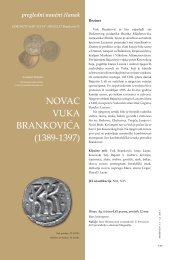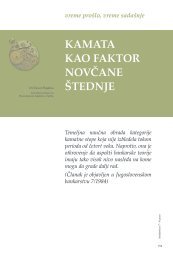novac đurđa brankovića (1427-1456) - Udruženje banaka Srbije
novac đurđa brankovića (1427-1456) - Udruženje banaka Srbije
novac đurđa brankovića (1427-1456) - Udruženje banaka Srbije
You also want an ePaper? Increase the reach of your titles
YUMPU automatically turns print PDFs into web optimized ePapers that Google loves.
pregledni naučni članak<br />
Svetlana Pantelić<br />
<strong>Udruženje</strong> <strong>banaka</strong> <strong>Srbije</strong><br />
svetlana.pantelic@ubs-asb.com<br />
UDK 737.1(497.11)"14"<br />
NOVAC<br />
ĐURĐA<br />
BRANKOVIĆA<br />
(<strong>1427</strong>-<strong>1456</strong>)<br />
Rad primljen: 25.01.2012.<br />
Odobren za štampu: 28.01.2012.<br />
Rezime<br />
Đurađ Vuković-Branković bio je gospodar<br />
Kosova 1402-1412. i despot Raške <strong>1427</strong>-<strong>1456</strong>.<br />
Ceo svoj život proveo je u borbi, pre svega<br />
sa Turcima i Ugrima, prihvatajući da bude<br />
i dvostruki vazal kako bi spasao sebe i svoju<br />
zemlju. Imao je petoro dece, sinove: Grgura,<br />
Stefana i Lazara i ćerke: Katarinu i Maru.<br />
Smederevo uzima za prestonicu a tvrđavu<br />
gradi od <strong>1427</strong>-1430. Umro je <strong>1456</strong>. a sahranjen<br />
u crkvi Krive Reke.<br />
Njegov <strong>novac</strong> ima najmanji obim i težinu,<br />
najčešće sa dvoglavim orlom ili lavom kao<br />
heraldičkim znakovima i sa stilizovanim<br />
krinovima i pahuljama. Razlikuju se, takođe,<br />
i po nastanku: u vreme vladavine na Kosovu,<br />
despotovine i obnovljene despotovine.<br />
Ključne reči: Đurađ Vuković-Branković,<br />
kovnica u Smederevu, rudnik u Rudištima,<br />
dvoglavio orao, lav, krin, snežne pahulje,<br />
maljušnik, Kosovo, despotovina, Smederevo,<br />
Jerina, Mara, Katarina, Grgur, Stefan, Lazar,<br />
Murat II, bakarni i posrebreni <strong>novac</strong><br />
JEL klasifikacija: N01, N23<br />
Dinar, Ag, težina 0,50 grama, prečnik 17 mm<br />
Lice: Despotova glava data kao portret.<br />
Naličje: Isus Hristos stoji u mandorli. U levoj ruci<br />
drži jevanđelje a desnom blagosilja.<br />
bankarstvo 1 2012<br />
110
ankarstvo 1 2012<br />
111<br />
Summary<br />
Djuradj Vuković-Branković was the ruler of<br />
Kosovo from 1402 till 1412, and the Prince of<br />
Raška from <strong>1427</strong> till <strong>1456</strong>. He spent his entire<br />
life fighting, mostly against the Turks and the<br />
Hungarians, accepting even the dual vassalage<br />
in order to save himself and his country. He<br />
fathered five children, sons: Grgur, Stefan and<br />
Lazar, and daughters: Katarina and Mara. After<br />
designated the city of Smederevo as his capital,<br />
he built the Smederevo fortress from <strong>1427</strong>-1430.<br />
He died in <strong>1456</strong>, and was buried in the church<br />
of Kriva Reka.<br />
The coins he minted were smaller in volume<br />
and weighed less, in most cases bearing the<br />
heraldic images of a two-headed eagle or a<br />
lion, or the stylized lilies and snowflakes. The<br />
coins can also be differentiated according to the<br />
period of minting: during the reign in Kosovo,<br />
during his princedom and during the renewed<br />
princedom.<br />
Key words: Djuradj Vuković-Branković, mint<br />
in Smederevo, mine in Rudište, two-headed<br />
eagle, lion, lily, snowflakes, „maljušnik“,<br />
Kosovo, princedom, Smederevo, Jerina, Mara,<br />
Katarina, Grgur, Stefan, Lazar, Murad II, copper<br />
and silver-coated coins<br />
JEL Classification: N01, N23<br />
Dinar, Ag, weight 0.50 grams, diameter 17 mm<br />
Obverse: Despot's head presented as a portrait.<br />
Reverse: Jesus Christ standing in mandorla. In<br />
his left hand he is holding the Holy Gospel, while<br />
blessing with his right hand.<br />
scientific review article<br />
UDC 737.1(497.11)"14"<br />
Svetlana Pantelić<br />
Association of Serbian Banks<br />
svetlana.pantelic@ubs-asb.com<br />
MONEY OF<br />
DJURADJ<br />
BRANKOVIĆ<br />
(<strong>1427</strong>-<strong>1456</strong>)<br />
Paper received: 25.01.2012<br />
Approved for publishing: 28.01.2012
S rednji sin Vuka Brankovića, Đurađ Branković, bio je<br />
gospodar Kosova od 1402-1412. a despot Raške od <strong>1427</strong>-<br />
<strong>1456</strong>. godine. Ceo svoj život, a živeo je preko osamdeset godina,<br />
pokušavao je na razne načine, vazalstvom, bračnim vezama,<br />
pregovorima i oruđem, da spase sebe i svoju zemlju. Povelja u<br />
svetogorskom manastiru Esfigmenu slika njegovo lepo i izražajno<br />
lice iz 1429. godine sa crnom bradom. Francuski plemić<br />
Bertrandan de la Brokijer posetio je 1433. godine<br />
despota - "lepog i krupnog gospodina".<br />
Bio je vazal Mađarskoj i Turskoj nadajući se<br />
da će dvostrukim vazalstvom svojoj zemlji<br />
uštedeti dalju krizu sa željom da vodi<br />
iskrenu politiku prema jednoj i drugoj<br />
državi. Nesrećan kao vladar bio je još<br />
nesrećniji kao otac. Sinove Grgura i Stefana<br />
po naređenju Murata II Turci su oslepeli,<br />
Katarina se udaje za Urliha Celjskog, Mara<br />
1435. za Murata II a najmlađi sin Lazar<br />
1446. ženi se Jelenom, bratanicom morejskog<br />
despota Konstantina Paleologa.<br />
Kada je Ugrima predao Beograd za upravni centar<br />
uzima Smederevo i ubrzano gradi <strong>1427</strong>-30. tvrđavu. Gradnja je<br />
zahtevala ogromne napore, finansijske i ljudske. Taj pojačani<br />
namet pripisan je u narodnoj književnosti bezobzirnosti Đurđeve<br />
druge žene Jerine Kantakuzin. Gubeći Rašku i Smederevo a želeći<br />
da se skloni od Murata II odlazi u Dubrovnik. Kralj Vladislav,<br />
erdeljski vojvoda Jan Hunjadi i Đurađ organizuju uspešan<br />
protivudar 1443-44. na Muratovu vosku. Đurađ dobija nazad<br />
svoje teritorije i oslepljene sinove. Umire <strong>1456</strong>. godine i biva<br />
sahranjen u crkvi Krive Reke.
Djuradj Branković, middle son of Vuk Branković, was the<br />
ruler of Kosovo from 1402 till 1412, and the Prince of Raška<br />
from <strong>1427</strong> till <strong>1456</strong>. He spent his entire life, and he lived over<br />
eighty years, resorting to different ways - vassalage, marital ties,<br />
negotiations and wars - of saving himself and his country. A<br />
charter from 1429 preserved at the Esphigmenou Monastery in<br />
Mount Athos depicts his beautiful and expressive face covered in<br />
black beard. In 1433, the French nobleman, Bertrandon de la<br />
Broquière, paid a visit to the Prince - “a handsome and sturdy<br />
gentleman”.<br />
He was a vassal of Hungary and Turkey, hoping that this<br />
dual vassalage would save his country from a further crisis,<br />
and wishing to lead an honest policy towards both above<br />
countries. Ill-fated as a ruler, he was even more unfortunate<br />
as a parent. At the order of Sultan Murad II, his sons Grgur<br />
and Stefan were blinded, his daughter Katarina married<br />
Ulrich of Celje, in 1435 his other daughter Mara married<br />
Sultan Murad II, and in 1446 his youngest son Lazar married<br />
Jelena, niece of the Morea Prince Constantine Palaiologos.<br />
After he handed Belgrade over to the Hungarians, he<br />
designated the city of Smederevo as his capital and built the<br />
Smederevo fortress from <strong>1427</strong>-1430. The construction required<br />
enormous efforts, both in terms of finances and in terms of labour<br />
power. The increased tolls were ascribed in the folklore literature<br />
to the cruelty of Djuradj’s second wife, Jerina Kantakuzin. Having<br />
lost Raška and Smederevo, and wishing to flee from Murad II,<br />
Djuradj went to Dubrovnik. In 1443-1444 King Vladislav, Duke<br />
of Erdelj Jan Hunjadi (John Hunyadi) and Djuradj organized<br />
a successful counter-attack against the Murad’s army. Djuradj<br />
won both his territories and his blinded sons back. He died in<br />
<strong>1456</strong> and was buried in the church of Kriva Reka.<br />
Smederevska tvrđava<br />
Smederevo fortress
Kod Đurđa Brankovića su naglašena tri perioda kovanja:<br />
(1) dok se kao oblasni gospodar Kosova borio sa ujakom<br />
Stefanom za ličnu nezavisnost; (2) period kada je kao ujakov<br />
naslednik bio na čelu despotovine do njenog pada 1439. godine;<br />
(3) u obnovljenoj despotovini od 1444. godine.<br />
Srpski <strong>novac</strong> u vreme despota Stefana Lazarevića i Đurđa<br />
Brankovića ima najmanji obim i težinu. Ova vrsta novca danas<br />
se zove obola a u narodu su poznati kao maljušnici.<br />
Na više vrsta novca Đurđa Brankovića njegovo ime je<br />
umetnički obrađeno.<br />
Dvoglavi orao sem kod despota Olivera i Stefana Lazarevića<br />
nalazi se i na jednoj vrsti novca despota Đurđa. Takođe, od<br />
heraldičkih oznaka na većini njegovih kovanica, po prvi put, se<br />
javlja lav porodice Branković. On je i na svim gradskim vrstama<br />
kovanim za vreme ovog vladara i njegovog sina despota Lazara<br />
Đurđevića.<br />
Na novcu Đurđa Brankovića susrećemo i stilističke novine<br />
renesansnog karaktera: cvet krina, snežnu pahuljicu i dr. kao<br />
i njegov realistički portret poput portreta na kovanicama cara<br />
Dušana i kneza Lazara.<br />
Falsifikovani <strong>novac</strong> izrađivan je i u kovnicama u vreme despota<br />
Đurđa Brankovića, o čemu postoje i arhivski podaci. Među tim<br />
bakarnim a posrebrenim primercima najčešći su lični i gradski<br />
novci despota Đurđa Brankovića.<br />
Kovnice novca postojale su u Smederevu, prestonici Đurđa<br />
Brankovića, sa vrlo brojnim emisijama i u rudarskom centru<br />
Rudišta.<br />
Povelja Đurđa Brankovića, 1430.<br />
godine, manastir Svetog Pavla<br />
Chart of Djuradj Branković,<br />
1430, St Paul’s Monastery<br />
Esfigmensku povelju izdao je despot Đurađ Branković<br />
11. septembra 1429. godine na molbu monaha manastira<br />
Esfigmena na Svetoj Gori da postane novi ktitor ovog<br />
manastira. Povelja je izrađena u manastiru Žiči. Na njoj<br />
je naslikan despot Đurađ sa despoticom Jerinom i njihovo<br />
petoro dece.<br />
The Esphigmenou Chart was issued by Prince Djuradj<br />
Branković on September 11th 1429, when he was asked by<br />
a monk from Esphigmenou Monastery on Mount Athos to<br />
become the new patron of this monastery. The Chart was<br />
produced in Žiča Monastery. It depicts Prince Djuradj<br />
with Princess Jerina and their five children.
Literatura / References<br />
There are three periods of coin-minting during the reign<br />
of Djuradj Brankovic: 1) while, as a regional ruler of<br />
Kosovo, he fought against his uncle Stefan for personal<br />
independence; 2) the period when, as his uncle’s successor,<br />
he ruled the princedom until its fall in 1439; 3) the period of the<br />
renewed princedom starting from 1444.<br />
In the times of Prince Stefan Lazarević and Prince Djuradj<br />
Branković, the Serbian coins were the smallest and the lightest. This type of<br />
coin is today called “obola”, and it also goes by the name of “maljušnik” (tiny).<br />
Several types of coins minted in the time of Djuradj Branković bear his<br />
artistically rendered name.<br />
The two-headed eagle, in addition to the coins of Prince Oliver and Stefan<br />
Lazarević, can also be found on one type of coins of prince Djuradj. Moreover,<br />
among the heraldic images<br />
inscribed in the majority of his<br />
coins, for the first time we can<br />
also find a lion as the symbol<br />
of the family of Branković.<br />
This symbol can also be found<br />
in all municipal coins minted<br />
during the reign of this ruler<br />
and his son prince Lazar<br />
Djurdjević.<br />
The coins of Djuradj<br />
Branković also feature some<br />
stylistic innovations in the<br />
renaissance style: blossom of<br />
a lily, a snowflake, etc, along<br />
with his realistic portrait, such<br />
as the portrait found in the<br />
coins of Emperor Dušan and<br />
prince Lazar.<br />
During the reign of Prince<br />
Djuradj Branković, counterfeit<br />
coins were also minted in the<br />
official mints, according to some data found in the archives. Among these<br />
copper and silver-coated samples, the most frequent are personal and<br />
municipal coins of Prince Djuradj Branković.<br />
Coin-mints, which minted profuse issues of coins, were to be found in the<br />
city of Smederevo, the capital of Djuradj Branković, and in the mine centre of<br />
Rudište.<br />
1. Ćorović, Vladimir. Istorija Srpskog naroda.<br />
2001.<br />
2. Dimitrijević, Sergije. Srednjovekovni srpski<br />
<strong>novac</strong>. Beograd, 1997.<br />
3. Jovanović, Miroslav. Srpski srednjovekovni<br />
<strong>novac</strong>. Beograd, 2001.<br />
4. Popović, Pero. Smederevo 1430 - 1939<br />
- Spomenica petstogodišnjice. Državna<br />
štamparija, 1931.<br />
5. Spremić, Momčilo. Despot Đurađ Branković<br />
i njegovo doba. Beograd: SKZ, 1994.













